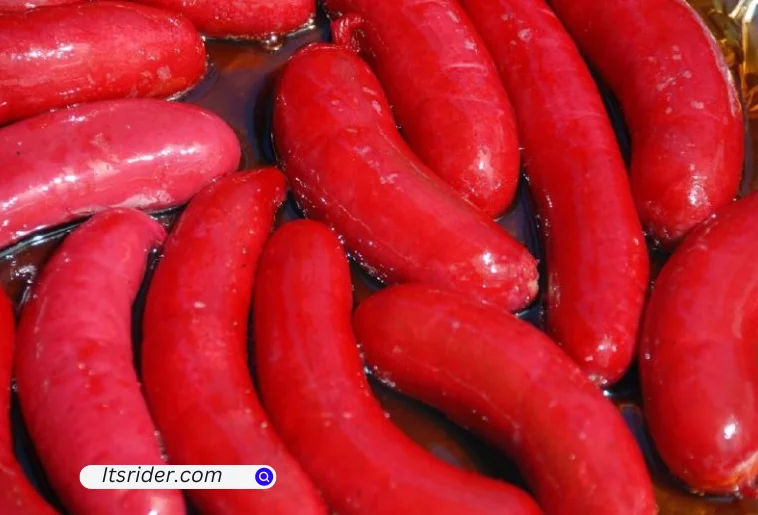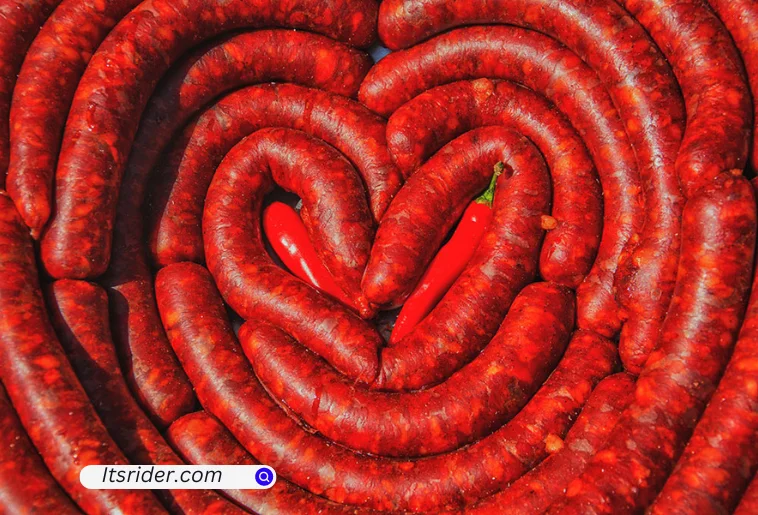The saveloy is a type of highly seasoned sausage that has been a staple of British cuisine for centuries. Recognizable by its bright red color and firm texture, this sausage holds a special place in the hearts of many who grew up enjoying it at local chip shops. In this comprehensive exploration, we will delve into the history, ingredients, preparation methods, variations, and cultural significance of the saveloy, highlighting its enduring appeal and versatility in modern cuisine.
Historical Origins
Early Beginnings
The saveloy’s origins can be traced back to the 19th century, though it draws inspiration from much older sausage traditions. The name “saveloy” is believed to be derived from the French word “cervelas,” which refers to a type of sausage made from pork brains. Over time, the recipe evolved, and the British version emerged as a distinct sausage with its own unique characteristics.
Evolution in the UK
During the Victorian era, the saveloy became a popular item in fish and chip shops across England. Its convenience, flavor, and affordability made it a favorite among the working class. The bright red color, achieved through food dye, helped it stand out among other sausages and contributed to its lasting visual appeal.
Traditional Ingredients

Core Components
The traditional saveloy is made from a combination of minced pork, rusk (a type of dry biscuit), and a blend of spices that typically includes white pepper, nutmeg, and mace. These ingredients are mixed together to form a fine, homogeneous texture.
Distinctive Red Color
One of the most recognizable features of the saveloy is its vibrant red color. This is achieved by adding a red food dye to the sausage mixture before it is encased. The dye not only gives the saveloy its signature look but also helps to preserve the sausage and maintain its appetizing appearance.
Preparation and Cooking Methods
Manufacturing Process
Saveloys are typically pre-cooked during the manufacturing process, making them quick and easy to prepare at home. The sausages are boiled or steamed to cook through and then cooled before packaging.
Home Preparation
To prepare saveloys at home, they are usually boiled or steamed until heated through. Boiling ensures the sausage retains its moisture and flavor, while steaming can provide a slightly firmer texture. Some people also enjoy grilling or frying saveloys for a different flavor profile.
Serving Suggestions
Saveloys are often served with chips (fries) and a variety of condiments, such as mustard, ketchup, or vinegar. They can also be enjoyed in a sandwich, often referred to as a “saveloy and chip butty” in the UK.
Regional Variations
United Kingdom
In the UK, saveloys are a staple of traditional fish and chip shops, particularly in the North of England. They are sometimes served with mushy peas or pickled onions, adding to their traditional charm.
Australia and New Zealand
In Australia and New Zealand, saveloys (often referred to as “savs”) are commonly found at fish and chip shops and are similar in taste and appearance to their British counterparts. They are a popular choice for quick, tasty meals.
South Africa
In South Africa, a similar sausage known as the “Russian” is popular. While not identical to the saveloy, it shares many characteristics and is often enjoyed in a similar fashion, typically with chips or as part of a larger meal.
Nutritional Information
Protein Content
Saveloys are rich in protein, thanks to their pork content. This makes them a good source of this essential nutrient, particularly for those who enjoy sausages as part of their diet.
Fat and Sodium
However, saveloys can also be high in fat and sodium, which are important considerations for those monitoring their intake of these components. As with many processed meats, it is best to enjoy saveloys in moderation and as part of a balanced diet.
Nutritional Profile
A typical saveloy contains approximately 200-250 calories per sausage, with around 15-20 grams of protein, 15-20 grams of fat, and 600-800 milligrams of sodium. These values can vary depending on the specific recipe and preparation method.
Modern Culinary Uses
Gourmet Dishes
In recent years, chefs and food enthusiasts have begun incorporating saveloys into more gourmet dishes. For example, saveloy hot dogs can be topped with a variety of ingredients such as sauerkraut, cheese, specialty sauces, and fresh vegetables for a modern twist on a classic favorite.
Fusion Cuisine
Saveloys have also found their way into fusion cuisine, where they are combined with elements from different culinary traditions. This can include saveloy tacos, where the sausage is sliced and served in a tortilla with fresh salsa and avocado, or saveloy stir-fry, where it is mixed with vegetables and served over rice.
Street Food
The rise of street food culture has also embraced the saveloy. Food trucks and market stalls often feature creative saveloy dishes, such as saveloy sliders or saveloy skewers, making this classic sausage accessible to a new generation of food lovers.
Making Saveloy at Home
Ingredients
To make saveloys at home, you will need:
- 1 kg minced pork
- 200 g rusk
- 20 g salt
- 10 g white pepper
- 5 g nutmeg
- 5 g mace
- Red food dye (optional)
- Sausage casings
Instructions
- Mix Ingredients: In a large bowl, combine the minced pork, rusk, salt, and spices. Mix thoroughly until the ingredients are evenly distributed.
- Add Dye: If desired, add a few drops of red food dye and mix until the color is uniformly distributed throughout the mixture.
- Stuff Sausages: Using a sausage stuffer, fill the casings with the mixture, twisting into individual sausages of your desired length.
- Cook: Boil the sausages in water for about 10 minutes, then allow them to cool before refrigerating. The sausages can be reheated by boiling or steaming when ready to serve.
The Saveloy’s Place in British Cuisine
Cultural Significance
The saveloy holds a special place in British cuisine as a beloved comfort food. Its association with traditional fish and chip shops and its nostalgic appeal make it a cherished part of many people’s culinary heritage.
Working-Class Roots
The saveloy’s popularity among the working class during the Victorian era helped cement its place in British food culture. Affordable and filling, it provided a hearty meal for those who needed sustenance for a long day’s work.
Modern Appeal
Today, the saveloy continues to be enjoyed by people of all ages and backgrounds. Its versatility and distinctive flavor ensure that it remains a popular choice in homes, restaurants, and street food markets alike.
Health Considerations
Moderation is Key
While saveloys are delicious, it is important to consider their nutritional content. High in fat and sodium, they should be enjoyed in moderation as part of a balanced diet. Opting for leaner versions or incorporating them into healthier meals can help mitigate some health concerns.
Healthier Alternatives
For those looking to enjoy saveloys with a healthier twist, there are options available. Using leaner cuts of pork, reducing the amount of added fat, and using whole grain rusk can help create a healthier version of this classic sausage.
Saveloy vs. Other Sausages
Saveloy vs. Frankfurter
While both saveloys and frankfurters are seasoned sausages, there are notable differences. Saveloys are typically spicier and have a firmer texture compared to the softer and milder frankfurter.
Saveloy vs. Hot Dog
Saveloys and hot dogs share similarities but differ in seasoning and preparation. Saveloys are more heavily spiced and often dyed red, whereas hot dogs are usually milder and more versatile in terms of toppings and condiments.
Saveloy vs. Russian
The Russian sausage, popular in South Africa, shares some similarities with the saveloy but has its own unique flavor profile and preparation methods. Both sausages are enjoyed in similar ways, often paired with chips or in sandwiches.
Sustainable and Ethical Considerations
Ethical Sourcing
As consumers become more conscious of food sourcing, the demand for ethically produced sausages has risen. Choosing saveloys made from responsibly sourced pork and supporting local butchers can contribute to more sustainable and ethical food practices.
Reducing Food Waste
Incorporating saveloys into a variety of dishes can help reduce food waste by making use of leftover sausages in creative ways. This not only minimizes waste but also adds variety to meals.
Exploring Global Sausage Traditions
Italian Sausages
Italian sausages, such as salami and mortadella, offer a rich variety of flavors and textures. These sausages often feature garlic, fennel, and other herbs, making them distinct from the spicier saveloy.
Spanish Chorizo
Spanish chorizo is known for its smoky flavor, achieved through the use of smoked paprika. While different from the saveloy, it shares the characteristic of being a highly seasoned sausage.
German Bratwurst
German bratwurst is a versatile sausage that can be grilled, fried, or boiled. It is often enjoyed with sauerkraut and mustard, providing a different taste experience compared to the saveloy.
Conclusion
The saveloy is more than just a sausage; it is a symbol of culinary heritage and tradition. Whether enjoyed in a traditional chip shop setting or as part of a modern gourmet dish, the saveloy continues to delight food enthusiasts with its unique flavor and rich history. Its enduring popularity is a testament to its place in the hearts and stomachs of many.
Read: CBD and Tobacco in Blunturi: A Comprehensive How-To Guide
